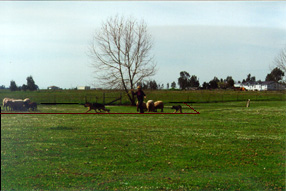Training Plans for Shepherd Dogs

In this photograph, we are working in a larger area than recommended because the adult dog is an experienced tending dog, and the pup is on a line. I am extending my training wand to signal the adult dog to stay on the boundary while I keep the pup on a long line more or less on the boundary. Khan, the pup, is only 4 months old here, so no corrections are in order.
Basic Requirements
The training program for a Shepherd Dog that will be doing practical ranch chores may differ from the "course training" that a dog preparing for trial titles or the HGH Breed Performance Test may receive from professional trainers. I will concentrate here on methods that take a raw young -- preferably a puppy -- shepherd dog from his first encounter with sheep to a finished, reliable, useful partner in sheep management. These methods have worked to produce really superb working dogs at my place. For the most part, I did not invent the training techniques; rather I learned centuries-old methods and modified them to fit my situation.
Do yourself a favor and choose the ideal candidate for starting this kind of work. A dog under one year of age with a strong desire to interact with the sheep. Schedule at least 2 half-hour sessions a week. Use 12 sheep of the strongly flocking varieties, not knee-hugging "dogged" sheep, but not fence-jumping wild sheep, either.
Set up your facilities as in the drawing. Equip yourself with a 12-foot lunge line and a safe, secure working type collar on the dog. For signalling the dog -- not for use on the dog's body -- use a long lunge whip with the tip wrapped in a feed sack. Take a look at the drawing below. It represents a small graze located in the corner of a field or in a small pen if the dog is very lively.

H=handler, D=dog, arrows indicate movement, solid line=fence, broken line=border
Goal
For the first 5 or 6 lessons, the dog will move freely, dragging the cord along the 2-sided border of the safety zone for the sheep, where they may simply stand and graze.
Method
1. Spot the sheep inside the border with the help of hay laid on the ground in a scatter pattern. A border may be created by a furrow, a few traffic cones, an old garden hose, a length of plastic fencing or metal irrigation pipes. In the beginning, it helps if the border is very visible.
2. Place the dog on a 12 ft. soft rope with a secure latch to his collar. Hold the dog securely by this cord, as short and as firmly as necessary to maintain control. Bring the dog to the gate of the field. Down the dog until the handler gets through the gate. Call the dog through. Down the dog again while closing the gate.
3. Sheep may leave their area and retreat to a far corner.
4. Keep the dog calm and on line (check cord). Lead the dog in the exact opposite direction that you want the sheep to go in order to get them back inside the borders. Do not lead the dog straight into the sheep at any time. 5. Once the sheep are inside the borders of their "graze," stand at the "corner" of the 2-sided training area. 6. Let the dog's instinct pull him in either direction along the outside of the border. Allow him to move at any speed, using the cord to check any attempt to come inside the safety zone marked by the border. 7. Do not simply stop the dog. Signal the dog that his attempt to enter the safety zone is "blocked" by extending the padded wand (lunge whip) as if it were a traffic arm at a railroad crossing.
8. The natural tending dog will turn and run in the opposite direction along the border. A dog with strong tending instincts will soon understand and enjoy his task of containing the sheep as if he were a "living fence."
9. Continue with this lesson until the dog shows that he acknowledges the safety zone of the flock and stays outside the border without any pressure on the check cord.
10. Drop the check cord and allow the dog to contain the sheep with his own instinct and ability.
Notes of caution: Do not lead the dog back and forth around the border in a mechanical manner. And above all, do not be tempted to use the dog's obedience as a method to achieve your goals. Do not command him to do the work. Allow him to discover how to get the job done. We must develop the innate ability and instincts of a natural tending dog. If you have a talented dog, you will quickly be out in larger training areas with a dog that "wears" (runs back and forth) alongside the flock and contains sheep movement, rather than pushing on your sheep all the time.
The next phase of the training is even more fun -- developing the skill of warding the sheep off nearby crops. You have questions???? Email me for possible answers.
![]() herdingdogs.com message board Comments, suggestions, ideas, opinions, questions, all are welcome to add to the discussion of the care, keeping, training and loving of our herding dogs.
herdingdogs.com message board Comments, suggestions, ideas, opinions, questions, all are welcome to add to the discussion of the care, keeping, training and loving of our herding dogs.